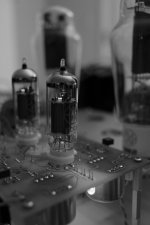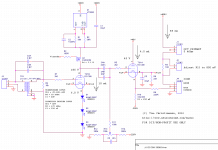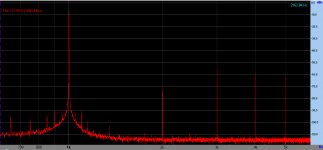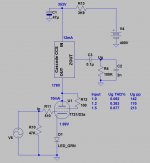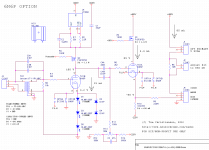Those of you who have followed my posts for a while know that I've been perfecting my 300B amp for a couple of years now. I think I've finally reached Audio Nirvana.
The main challenge driving a 300B is that the driver will have to swing 160~180 Vpp, cleanly. The ECC99 from JJ fits this bill very nicely. It's a medium µ tube (µ = 22), in current production, and reasonably priced ($15/EA). I've tried several other tubes - 6SN7, 6SL7, d3A, etc. - but they either can't swing 180 Vpp cleanly or can't provide 180 Vpp at all at reasonable bias points. The 6SN7/6J5 comes close, but the ECC99 is much lower THD.
I tried several circuit topologies and ended up settling on using one ECC99 per channel. One half of the ECC99 provides a CCS loaded, LED biased common cathode amplifier stage with a gain of roughly 20 V/V. The other half of the ECC99 is rigged as a cathode follower driving the 300B.
The high gm of the ECC99 (9.5 mA/V) ensures a low output impedance of the cathode follower (Zout = 100 ohm). Hence, the driver's output impedance is dominated by the grid stopper on the 300B.
My first prototype has been playing in my living room for a few months while I've been tweaking it. I'm likin' it. I plan to offer boards for this amp sometime in the fall.
~Tom
The main challenge driving a 300B is that the driver will have to swing 160~180 Vpp, cleanly. The ECC99 from JJ fits this bill very nicely. It's a medium µ tube (µ = 22), in current production, and reasonably priced ($15/EA). I've tried several other tubes - 6SN7, 6SL7, d3A, etc. - but they either can't swing 180 Vpp cleanly or can't provide 180 Vpp at all at reasonable bias points. The 6SN7/6J5 comes close, but the ECC99 is much lower THD.
I tried several circuit topologies and ended up settling on using one ECC99 per channel. One half of the ECC99 provides a CCS loaded, LED biased common cathode amplifier stage with a gain of roughly 20 V/V. The other half of the ECC99 is rigged as a cathode follower driving the 300B.
The high gm of the ECC99 (9.5 mA/V) ensures a low output impedance of the cathode follower (Zout = 100 ohm). Hence, the driver's output impedance is dominated by the grid stopper on the 300B.
My first prototype has been playing in my living room for a few months while I've been tweaking it. I'm likin' it. I plan to offer boards for this amp sometime in the fall.
~Tom
Attachments
I assume you call it a death trap because of the exposed circuit.
And the black and white picture adds that final extra of morbidity. Not long ago I thought about calling one of my amps 'Electro-Cute'. It was cute and dangerous.
I assume you call it a death trap because of the exposed circuit.
My prototypes are usually built point-to-point on a piece of plywood. Hence, the DeathTrap name... My present amp isn't complete, obviously. It'll need an enclosure and such.
And although I've never owned or used one, have you tried the Russian 6H30 dual triode?
I have not. A quick glance at the plate curves reveal that it would be a good candidate as well. The µ is a bit low (15) so it'd take a preamp with some oomph to drive a 300B into clipping. But it could be interesting to try.
~Tom
Member
Joined 2009
Paid Member
You use a CCS load for the common cathode amp stage, why didn't you use one for the common cathode stage instead of R10 too ?
or if you prefer,
Why didn't you use a resistor load for the common cathode amp stage instead of the more complex CCS ?
I'm assuming you meant cathode follower.. Not speaking for Tom here, but the load resistor R10 is quite large compared to the internal cathode source impedance, the CCS would provide less benefit here, and if it failed open would take the 300B with it.
There are at least three reasons I can think of to use a CCS as a plate load in a common cathode stage, one is to maximize gain which is needed here, another is for the good linearity it provides, and finally it reduces the required driver supply voltage required rather significantly for comparable performance with a resistive load.. Another obvious advantage of a CCS is the high PSRR it will provide.
I've tried several other tubes - 6SN7, 6SL7, d3A, etc. - but they either can't swing 180 Vpp cleanly or can't provide 180 Vpp at all at reasonable bias points.
What's wrong with the D3a? It can swing more than 200Vpp...
What's wrong with the D3a? It can swing more than 200Vpp...
I use them to drive GM70 which they do quite well. I have future plans for an IT coupled D3A/300B amp..
I'm assuming you meant cathode follower.. Not speaking for Tom here, but the load resistor R10 is quite large compared to the internal cathode source impedance, the CCS would provide less benefit here, and if it failed open would take the 300B with it.
There are at least three reasons I can think of to use a CCS as a plate load in a common cathode stage, one is to maximize gain which is needed here, another is for the good linearity it provides, and finally it reduces the required driver supply voltage required rather significantly for comparable performance with a resistive load.. Another obvious advantage of a CCS is the high PSRR it will provide.
That sums it up quite nicely, actually. On the common cathode stage, I used the CCS load to maximize gain and minimize THD. I tried a CCS on the cathode follower as well but the difference (both in measurements and listening tests) between a CCS and the 33 kOhm resistor was negligible. I figured a resistor beats a CCS on price and complexity any day so I stuck with that.
~Tom
What's wrong with the D3a? It can swing more than 200Vpp...
There's nothing *wrong* with the d3A. In fact, it's a very nice tube. But I found I got better performance (lower THD) with the ECC99. I just wasn't able to find a good operating point on the d3A - one that would allow both for low THD and provide the needed swing. The d3A is also fairly pricey... I would prefer to use a tube that's in current production or abundantly available.
6N6P for driver?
That's much more interesting than the 6H30 mentioned earlier. At least much more reasonably priced. I may take a look at that.
~Tom
I built my SET amp for a JJ ecc99 driver tube, but I ended up preferring Sylvania 12BH7A. I think the JJ ecc99 is a close copy of a 12BH7, no parts value changes were required or even ideal for the swap... I got 3 of them right now, all are good tubes and cost under $15 each.
Congrats on your 300b amp, looks great!
Congrats on your 300b amp, looks great!
Last edited:
I've been doing some nosing around on the net, and opinions vary as to whether the ECC99 or the 6N6P is the better driver tube. If I recall, someone did a "shootout" comparison between the ECC99 and various other tubes in Audio Amateur when the ECC99 first came out. The 6N6P may have been one of the contenders, maybe not. I'd have to go back and look at the article again to get the particulars. I was only mildly interested at the time, as I wasn't actively building tube stuff back then. Times have changed...
Hello,
I have directly compared these tubes in the same headphone amplifier, as the voltage amplifier, coupled by a teflon cap to a SS buffer.
The 12BH7 (various brands) is one of my favorite tubes, one of the few "magical sounding" ones.
The D3a also sounds fantastic, definitely better than the ECC99 to my ears.
I tried a gold pin, factory selected ECC99; it's a good tube, but lacks a little something...
I also tried different 6N6P tubes. I don't like them, I'll never use them in any amp.
Oh, and 12BH7 and ECC99 are quite different - lower plate resistance / higher transconductance and 3x maximum current for the ECC99. But they can be sometimes substituted, indeed.
I have directly compared these tubes in the same headphone amplifier, as the voltage amplifier, coupled by a teflon cap to a SS buffer.
The 12BH7 (various brands) is one of my favorite tubes, one of the few "magical sounding" ones.
The D3a also sounds fantastic, definitely better than the ECC99 to my ears.
I tried a gold pin, factory selected ECC99; it's a good tube, but lacks a little something...
I also tried different 6N6P tubes. I don't like them, I'll never use them in any amp.
Oh, and 12BH7 and ECC99 are quite different - lower plate resistance / higher transconductance and 3x maximum current for the ECC99. But they can be sometimes substituted, indeed.
Hi Tom!
My 300B SET:
Siemens E280F/D3a (the last is most dynamic, but the 280F is most refining), 10mA anode current, green LED bias, cascode (DN2540) anode CCS, V-Cap TFTF 100nF coupling, "powerdrive" (TubelabSE) by FET, 300B 70mA, 5K:8 OPT, 400V B+.
Over 6W A2 mode (160Vpp Ug), clipping at 10W.
Driver schematic, and spectrum at 200Vpp:
My 300B SET:
Siemens E280F/D3a (the last is most dynamic, but the 280F is most refining), 10mA anode current, green LED bias, cascode (DN2540) anode CCS, V-Cap TFTF 100nF coupling, "powerdrive" (TubelabSE) by FET, 300B 70mA, 5K:8 OPT, 400V B+.
Over 6W A2 mode (160Vpp Ug), clipping at 10W.
Driver schematic, and spectrum at 200Vpp:
Attachments
For those using the d3A; what operating point are you running at?
I seem to recall running at 12 mA, Vgk = 1.75 V without great success. It was decent, but the THD was a bit high. It looks like operating points around 20 mA, Vgk = 1.25 V would be better.
~Tom
I'm running at 20mA triode connected and approximately 1.6V grid bias..
6N6P for driver?
That was my best choice to drive a 300B. Wonderfull!
Of course the 300B is just driving a GM70, but there is never lack of swing or power.
Universal 300B Driver?
Folks,
I've read through your suggestions, which so far include: 6H30, 12BH7A, d3A, and 6N6P.
I'm landing on attached circuit. It is capable of using 6N6P, ECC99, 12BH7A, and with some wired-in sockets, d3A in triode configuration. Switching between 6N6P and ECC99/12BH7A is accomplished by moving two wire jumpers. These could be connected to a switch if one wanted to roll tubes.
I haven't been able to dig up an actual data sheet for the 6H30, but Triode Electronics have posted some plate curve measurements. It looks like a nice tube. And judging from the $35/EA cost, it looks like others like it too. But without a data sheet and with measured characteristics that will requiring operating points that stress my circuit thermally, I think I'll pass.
So far, I have listened to the ECC99, d3A, and 6N6P. I really like the latter. To my ears and on my system, the d3A sounds slightly muddy in the highs. There's a pronounced lisp on hard consonants. But it also resolves a lot of detail on metallic instruments (cymbals and the like). In the end, I find the lisp hard to listen to. The ECC99 looses the lisp, but also some of the detail. It's quite pleasant to listen to in my view. The transient response with the ECC99 is quite nice. But the 6N6P takes the cake. It's a good middle ground between the ECC99 and the d3A. I find it really pleasing to my ears.
The THD (1 kHz) comes in as follows:
d3A: 0.32 % @ 1 W; 1 % @ 8.5 W
ECC99: 0.18 % @ 1 W; 1 % @ 8.9 W
6N6P: 0.16 % @ 1 W; 1 % @ 9.7 W
These were the bias conditions:
d3A: Vgk = 2 V; Ia = 10 mA
ECC99: Vgk = 6 V; Ia = 10 mA
6N6P: Vgk = 6.2 V; Ia = 15 mA
I have a pair of Electro-Harmonix 12BH7A on the way and will have a look at those later in the week. My intent is to use Vgk = 11 V (two 5.6 V zeners in series) for biasing. I'll run them at 10~12 mA.
Note that both the ECC99 and the 12BH7A are in current production.
~Tom
Folks,
I've read through your suggestions, which so far include: 6H30, 12BH7A, d3A, and 6N6P.
I'm landing on attached circuit. It is capable of using 6N6P, ECC99, 12BH7A, and with some wired-in sockets, d3A in triode configuration. Switching between 6N6P and ECC99/12BH7A is accomplished by moving two wire jumpers. These could be connected to a switch if one wanted to roll tubes.
I haven't been able to dig up an actual data sheet for the 6H30, but Triode Electronics have posted some plate curve measurements. It looks like a nice tube. And judging from the $35/EA cost, it looks like others like it too. But without a data sheet and with measured characteristics that will requiring operating points that stress my circuit thermally, I think I'll pass.
So far, I have listened to the ECC99, d3A, and 6N6P. I really like the latter. To my ears and on my system, the d3A sounds slightly muddy in the highs. There's a pronounced lisp on hard consonants. But it also resolves a lot of detail on metallic instruments (cymbals and the like). In the end, I find the lisp hard to listen to. The ECC99 looses the lisp, but also some of the detail. It's quite pleasant to listen to in my view. The transient response with the ECC99 is quite nice. But the 6N6P takes the cake. It's a good middle ground between the ECC99 and the d3A. I find it really pleasing to my ears.
The THD (1 kHz) comes in as follows:
d3A: 0.32 % @ 1 W; 1 % @ 8.5 W
ECC99: 0.18 % @ 1 W; 1 % @ 8.9 W
6N6P: 0.16 % @ 1 W; 1 % @ 9.7 W
These were the bias conditions:
d3A: Vgk = 2 V; Ia = 10 mA
ECC99: Vgk = 6 V; Ia = 10 mA
6N6P: Vgk = 6.2 V; Ia = 15 mA
I have a pair of Electro-Harmonix 12BH7A on the way and will have a look at those later in the week. My intent is to use Vgk = 11 V (two 5.6 V zeners in series) for biasing. I'll run them at 10~12 mA.
Note that both the ECC99 and the 12BH7A are in current production.
~Tom
Attachments
Last edited:
- Status
- This old topic is closed. If you want to reopen this topic, contact a moderator using the "Report Post" button.
- Home
- Vendor's Bazaar
- DeathTrap400™ : : A Pretty Damn Good 300B Amp
